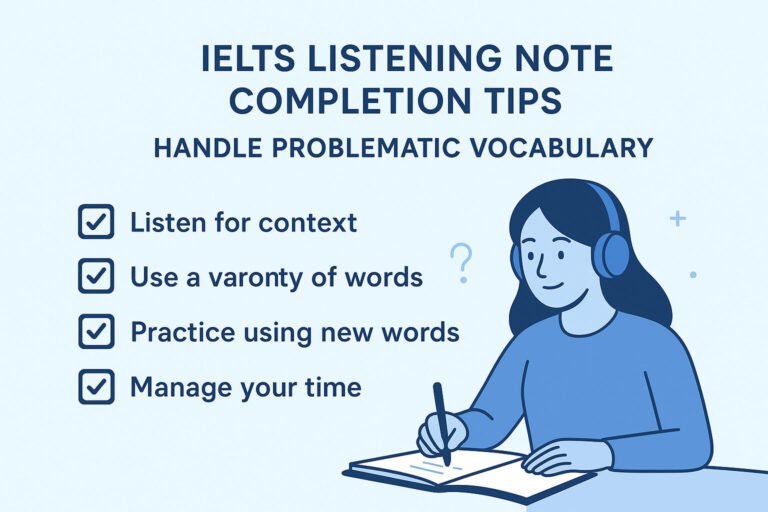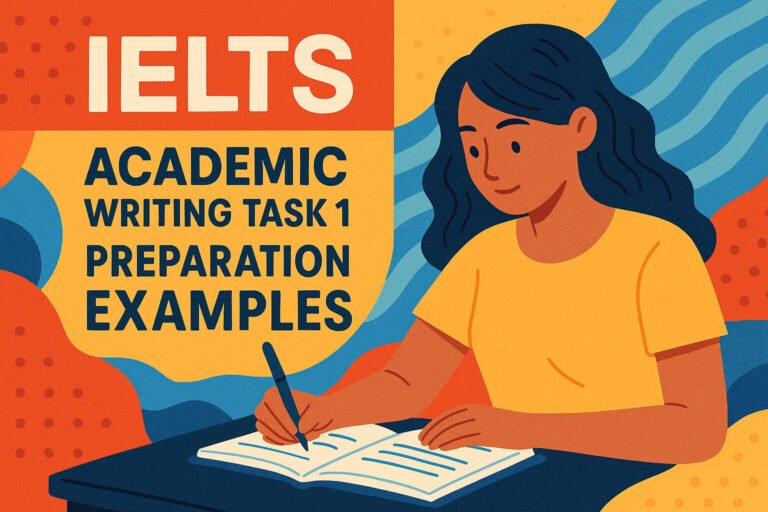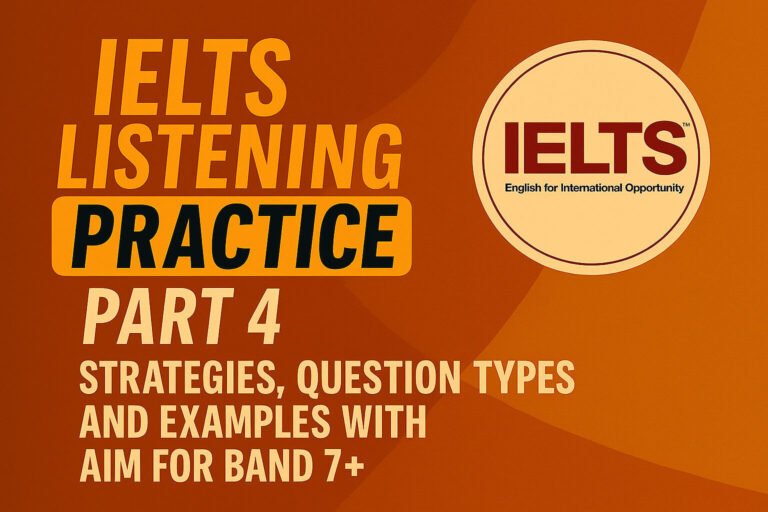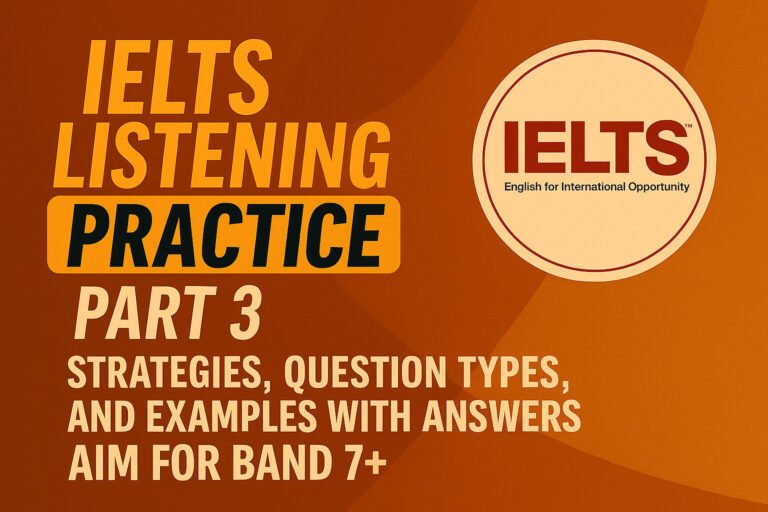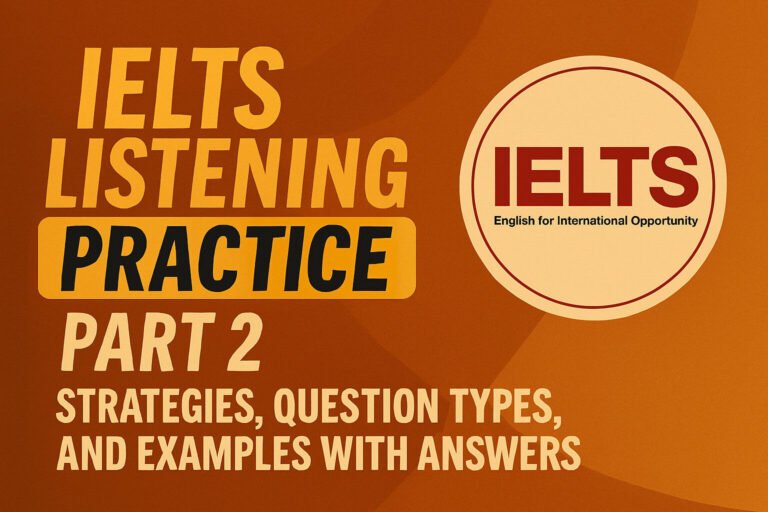Boost your skills with IELTS listening practice part 1 tips, question types, and examples with answers. Ace the test and aim for band 7+—start your free practice today!. In the IELTS Listening Practice Part 1 test, especially in the opening section? Many test-takers lose points here because they miss key information in casual conversations. This guide focuses on IELTS listening practice part 1, offering tips, strategies, and real examples to build your confidence. By the end, you’ll know how to handle common question types and improve your score step by step.
We’ll dive into the structure, explore IELTS listening part 1 question types with answers, and provide practice exercises. Let’s turn your listening skills into a strength!
What is IELTS Listening Part 1? Get the Basics Right
IELTS Listening Part 1 is the first section of the 30-minute test, where you hear a conversation between two people in an everyday setting. It could be about booking a hotel, planning a trip, or discussing daily plans. There are 10 questions, and the audio plays only once.
This part tests your ability to pick up specific details like names, dates, or numbers. It’s the easiest section, but it sets the tone for the rest. With good IELTS listening practice part 1, you can start strong and aim for fewer mistakes.
Remember, you get time to read questions before the audio starts. Use it wisely to predict answers and stay focused.
Why Focus on IELTS Listening Practice Part 1?
Practicing Part 1 helps you get used to different accents, like British or Australian, and everyday language. Many aspirants struggle because the speech is natural and fast-paced, with distractions in the audio.
Regular IELTS listening practice part 1 builds your concentration and note-taking skills. It also familiarizes you with question formats, so you’re not surprised on test day. Start with simple exercises and gradually increase difficulty for better results.
Think of it as training your ears—like warming up before a run. Consistent practice leads to higher bands.
Common IELTS Listening Part 1 Question Types
Understanding IELTS listening part 1 question types is key to scoring well. This section often includes forms, notes, or short answers that require exact details from the audio.
Here are the main IELTS listening question types with examples:
- Form Completion: Fill in blanks on a form, like a registration sheet. Example: “Name: ________” – Listen for spellings.
- Note Completion: Complete notes with words or numbers. Example: “Meeting time: ________ PM”.
- Table Completion: Fill a table with missing info. Example: Rows for dates and columns for activities.
- Multiple Choice: Choose from options A, B, or C. Example: “What is the address? A) 12 Maple St B) 21 Oak Rd C) 34 Pine Ave”.
- Short Answer Questions: Respond with 1-3 words. Example: “What is the phone number?”
These IELTS listening part 1 question types with answers help you practice precision. Always check word limits, like “no more than two words.”
Strategies to Master IELTS Listening Part 1
To excel, use smart techniques during IELTS listening practice part 1. First, preview questions to spot keywords like “time” or “location.”
Listen for signposts—words like “first” or “next”—that signal important info. Note synonyms, as the audio might paraphrase questions.
Practice active listening: Jot quick notes, but don’t write full sentences. After, transfer answers carefully in the 10-minute window.
Action step: Do one practice daily. Time yourself and review mistakes to see patterns.
IELTS Listening Part 1 Question Types with Answers: Real Examples
Let’s look at IELTS listening question types with examples. Imagine an audio about booking a tour.
Example 1: Form Completion
Complete the form below. Write NO MORE THAN TWO WORDS AND/OR A NUMBER for each answer.
Tour Booking Form
Name: (1) ________
Date: (2) ________
Number of people: (3) ________
Answers: (1) John Smith (2) 15th June (3) four
Tip: Spell names correctly—common error!
Example 2: Multiple Choice
Choose the correct letter, A, B, or C.
What time does the tour start?
A) 9 AM
B) 10 AM
C) 11 AM
Answer: B) 10 AM
In the audio: “We’ll begin at ten in the morning.”
Example 3: Note Completion
Complete the notes below. Write ONE WORD ONLY for each answer.
Tour includes: (4) ________ visit
Lunch at: (5) ________ restaurant
Answer: (4) museum (5) seaside
These IELTS listening part 1 question types with answers show how to match audio to questions.
Free IELTS Listening Practice Part 1 Exercises
Try this IELTS listening practice part 1 exercise. Assume audio about a library membership.
Questions 1-5: Complete the form. No more than two words/numbers.
Library Membership
Full name: (1) ________
Address: (2) ________ Street
Membership fee: (3) ________ dollars
Books limit: (4) ________
Renewal date: (5) ________
Answers (hypothetical): (1) Anna Lee (2) 45 Elm (3) 20 (4) five (5) one year
Review: Check if you caught numbers and spellings.
Another practice: Multiple choice on a phone call about a class.
What is the class about?
A) Cooking
B) Painting
C) Dancing
Answer: B) Painting
Practice these to build speed.
Tips for Handling Numbers and Spellings in Part 1
Numbers and spellings are tricky in IELTS listening practice part 1. Dates might be “fifteenth” or “15th”—write as heard.
For phones: Listen for groups, like “zero two one…”
Tip: Practice dictation of numbers. Use apps for varied accents.
Action: List common misspellings and correct them.
Building Vocabulary for IELTS Listening Part 1
Everyday topics mean common words: directions, times, places.
Build lists: Transport (bus, train), Accommodations (hotel, room).
LSI terms: “daily conversations,” “social contexts.”
Incorporate in practice to recognize paraphrases.
Advanced Techniques for Higher Bands
For band 7+, predict answers during preview. If question says “time,” expect “o’clock” or “PM.”
Ignore distractors—audio might change info, like “not 5, but 6 PM.”
Record yourself reviewing answers for improvement.
Table: IELTS Listening Part 1 Question Types Overview
| Question Type | Description | Example | Tip |
|---|---|---|---|
| Form Completion | Fill personal details | Name: _____ | Check spelling |
| Note Completion | Add to notes | Time: _____ | Use keywords |
| Multiple Choice | Select option | A/B/C | Eliminate wrong ones |
| Short Answer | Brief response | What color? _____ | Word limit |
| Table Completion | Fill grid | Date | Activity | Scan quickly |
This table summarizes IELTS listening part 1 question types for quick reference.
Common Mistakes and How to Avoid Them
Many skip preview time—don’t! Read all 10 questions.
Overwriting: Stick to limits.
Panicking: If missed, guess and move on.
Tip: Practice under timed conditions.
Daily Practice Plan for IELTS Listening Part 1
Week 1: Focus on question types, one per day.
Week 2: Full Part 1 practices, review transcripts.
Action: Track scores, aim for 8/10.
Use free resources like British Council samples.
FAQ: Your Questions on IELTS Listening Practice Part 1
What are the main IELTS listening part 1 question types?
Common ones include form completion, note completion, and multiple choice. Practice with examples to get familiar.
How can I find free IELTS listening practice part 1 with answers?
Check official sites like British Council or IDP for samples. They offer audio and keys for self-study.
Why do I miss details in IELTS listening question types with examples?
It could be accents or speed. Practice daily with varied audio to improve focus.
How long is IELTS Listening Part 1?
It’s about 3-4 minutes of audio, with 10 questions. You get preview time too.
Can I write in capitals for answers?
Yes, but ensure spellings match the audio exactly.
What if I spell a name wrong in Part 1?
It costs a point. Practice dictation of names and places.
Mastering IELTS listening practice part 1 is your gateway to a strong start. Keep practicing, stay positive, and you’ll see progress. For more guides, visit IELTSNest.com. Good luck!


